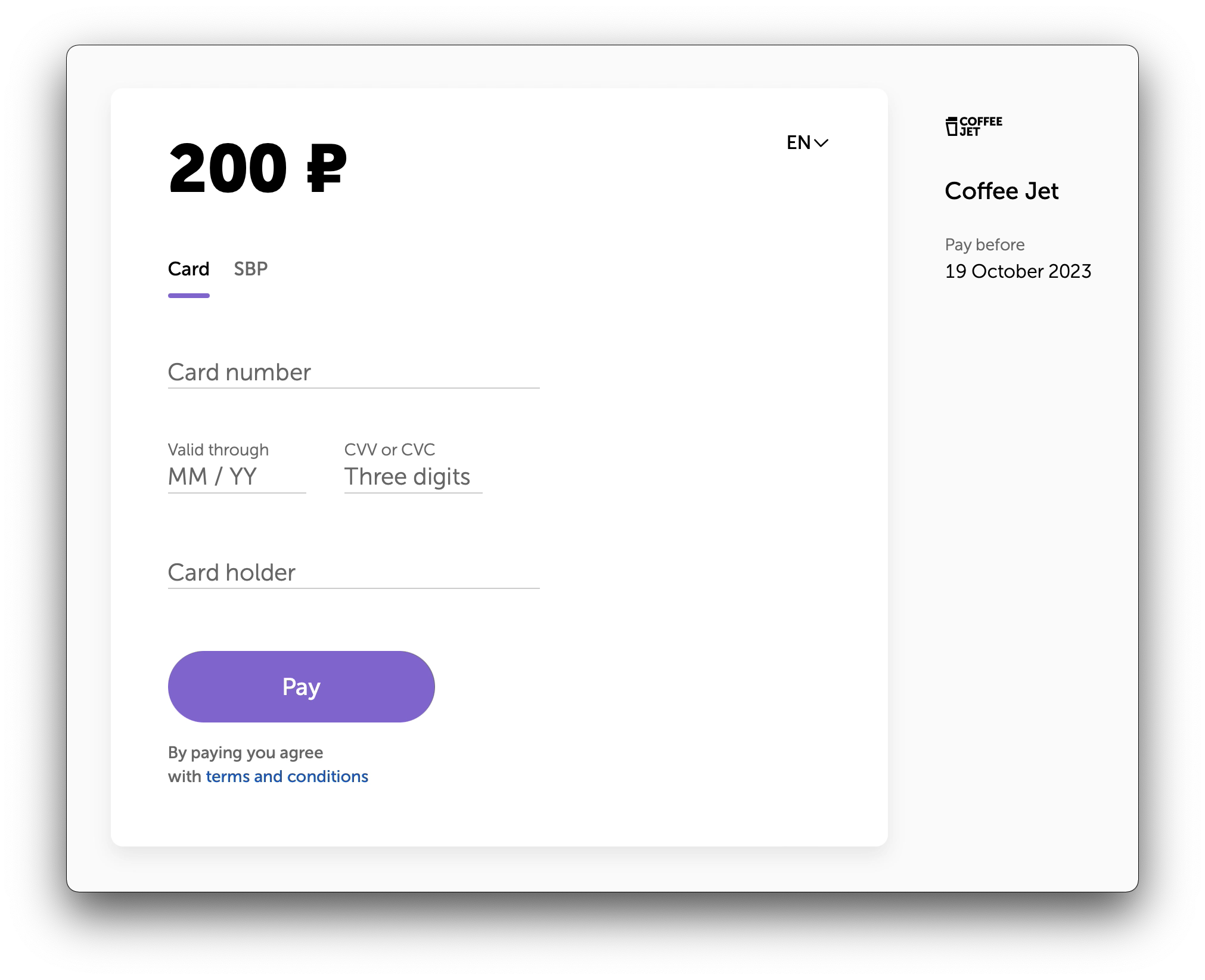QIWI Payment Form¶
The QIWI form is designed for filling payment details for the purchase of goods or services. When paying with the QIWI form, the partner does not receive, process, or store clients payment data (such as card details). The form handles this.
Customization¶
Customization allows you to configure the appearance of the form.
The following elements can be customized:
| Element | Requirements | Customization is required |
|---|---|---|
| Logo | PNG or SVG format, size 48x48 or proportional larger | ✅ |
| Buttons color | HEX format | ✅ |
| Provider or service name | ✅ | |
| Service agreement link |
To customize the form, contact the support service and provide:
- A list of elements that require customization (see table above).
siteIdand a unique style code for the form (you can use numbers, Latin letters, and hyphens-).
As a result, the code, and therefore the appearance of the form, will be associated with a specific siteId.
To apply a style to the form, pass the code in the:
-
themeCodeparameter of thecustomFieldsobject in the invoice creation request if the scenario involves payment using the API.Example
"themeCode": "merchant01-theme01" -
extras[themeCode]in the direct form call if the scenario involves payment without using the API.Example
...&extras[themeCode]=merchant01-theme01
Please note
The code value is case-sensitive.
Form Example

Form URL¶
The URL of the QIWI payment form is returned in response to the invoice creation request , and is contained in the payUrl parameter. The partner directs the client to the received URL for order payment.
The partner can independently add parameters to the original payUrl:
| Parameter | Description | Value |
|---|---|---|
| successUrl | See the «URL for Successful Payment» section | URL-encoded string |
| lang | Form language. The default language is Russian (ru) |
ru, en |
| paymentMethod | See the «Payment Methods» section in the «Payment Acceptance» article → «QIWI Form Payment» → «QIWI Form Payment using the API» | CARD, SBP, QIWI_WALLET |
https://oplata.qiwi.com/form?invoiceUid=606a5f75-4f8e-4ce2-b400-967179502275&successUrl=https://example.com/payments/#introduction
Opening the Form in an Iframe¶
When opening the URL of the form in an iframe (iframe src="<payUrl link>..." />), the partner can use the postMessage method to track the form’s states.
Possible states:
- INITIALIZED — form loaded.
- PAYMENT_ATTEMPT — payment attempt.
- PAYMENT_SUCCEEDED — successful payment.
- PAYMENT_FAILED — payment failed.
- INITIALIZATION_FAILED — form loading error.
window.addEventListener('message', function (event) {
switch (event.data) {
case 'INITIALIZED':
// form loaded
break;
case 'PAYMENT_ATTEMPT':
// payment attempt
break;
case 'PAYMENT_SUCCEEDED':
// successful payment
break;
case 'PAYMENT_FAILED':
// payment failed
break;
}
}, false)
Please note
If the form is opened in an iframe from the partner’s website, QIWI Wallet payment may not be available: during authentication in QIWI Wallet, cookies of the qiwi.com domain are set, and some browsers block the setting of cookies from third-party domains. See the WebKit documentation for details.
URL for Successful Payment¶
After payment on the QIWI form, the client can be redirected from the form to a specific page on the partner’s website via successUrl. The client will be at successUrl 3-10 seconds after a successful transaction.
When the client is redirected to successUrl, the partner can understand that the client has paid for the goods or services, and the status of the transaction in QIWI will change shortly.
Please note
To make a decision regarding the success of a transaction, the partner needs to follow the actions outlined in the article «General Principles and Rules» → «Decision on Transaction Success».
The URL should be specified in UTF-8 encoding.
Language¶
The form supports two languages: Russian and English. The default language is Russian, but this can be changed by contacting the support manager.